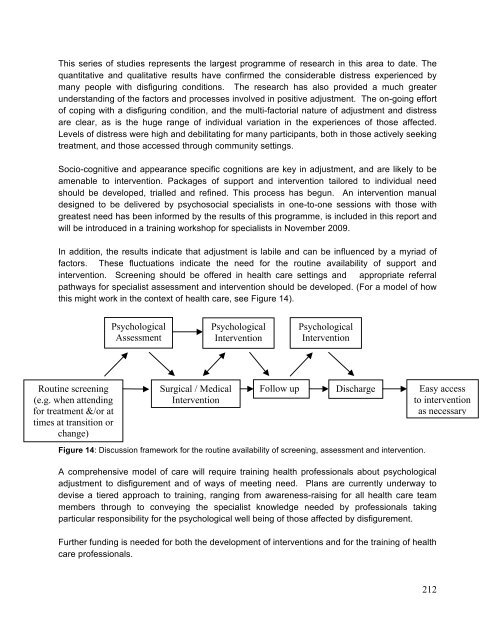Download the report - The Healing Foundation
Download the report - The Healing Foundation
Download the report - The Healing Foundation
Create successful ePaper yourself
Turn your PDF publications into a flip-book with our unique Google optimized e-Paper software.
This series of studies represents <strong>the</strong> largest programme of research in this area to date. <strong>The</strong><br />
quantitative and qualitative results have confirmed <strong>the</strong> considerable distress experienced by<br />
many people with disfiguring conditions. <strong>The</strong> research has also provided a much greater<br />
understanding of <strong>the</strong> factors and processes involved in positive adjustment. <strong>The</strong> on-going effort<br />
of coping with a disfiguring condition, and <strong>the</strong> multi-factorial nature of adjustment and distress<br />
are clear, as is <strong>the</strong> huge range of individual variation in <strong>the</strong> experiences of those affected.<br />
Levels of distress were high and debilitating for many participants, both in those actively seeking<br />
treatment, and those accessed through community settings.<br />
Socio-cognitive and appearance specific cognitions are key in adjustment, and are likely to be<br />
amenable to intervention. Packages of support and intervention tailored to individual need<br />
should be developed, trialled and refined. This process has begun. An intervention manual<br />
designed to be delivered by psychosocial specialists in one-to-one sessions with those with<br />
greatest need has been informed by <strong>the</strong> results of this programme, is included in this <strong>report</strong> and<br />
will be introduced in a training workshop for specialists in November 2009.<br />
In addition, <strong>the</strong> results indicate that adjustment is labile and can be influenced by a myriad of<br />
factors. <strong>The</strong>se fluctuations indicate <strong>the</strong> need for <strong>the</strong> routine availability of support and<br />
intervention. Screening should be offered in health care settings and appropriate referral<br />
pathways for specialist assessment and intervention should be developed. (For a model of how<br />
this might work in <strong>the</strong> context of health care, see Figure 14).<br />
Routine screening<br />
(e.g. when attending<br />
for treatment &/or at<br />
times at transition or<br />
change)<br />
Psychological<br />
Assessment<br />
Surgical / Medical<br />
Intervention<br />
Psychological<br />
Intervention<br />
Psychological<br />
Intervention<br />
Follow up Discharge Easy access<br />
to intervention<br />
as necessary<br />
Figure 14: Discussion framework for <strong>the</strong> routine availability of screening, assessment and intervention.<br />
A comprehensive model of care will require training health professionals about psychological<br />
adjustment to disfigurement and of ways of meeting need. Plans are currently underway to<br />
devise a tiered approach to training, ranging from awareness-raising for all health care team<br />
members through to conveying <strong>the</strong> specialist knowledge needed by professionals taking<br />
particular responsibility for <strong>the</strong> psychological well being of those affected by disfigurement.<br />
Fur<strong>the</strong>r funding is needed for both <strong>the</strong> development of interventions and for <strong>the</strong> training of health<br />
care professionals.<br />
212


